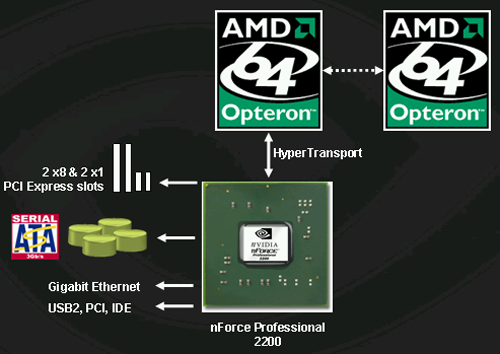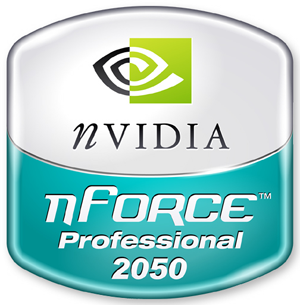NVIDIA nForce Professional Brings Huge I/O to Opteron
by Derek Wilson on January 24, 2005 9:00 AM EST- Posted in
- CPUs
NVIDIA nForce Pro 2200 MCP and 2050 MCP
There will be two different MCPs in the nForce Professional lineup: the nForce Pro 2200 and the nForce Pro 2050. The 2200 is a full-featured MCP, and while the 2050 doesn't have all the functionalty of the 2200, they are based on the same silicon. The feature set of the NVIDIA nForce Pro 2200 MCP is just about the same as the nForce 4 SLI and is as follows:
- 1 1GHz 16x16 HyperTransport Link
- 20 PCI Express lanes configurable over 4 physical connections
- Gb ethernet w/ TCP/IP offload Engine (TOE)
- 4 SATA 3Gb/s
- 2 ATA-133 channels
- RAID and NCQ support (RAID can span SATA and PATA)
- 10 USB 2.0
- PCI 2.3
The 20 PCI Express lanes can be spread out over 4 controllers at the motherboard vendor's discretion via NVIDIA's internal crossbar connection. For instance, a board based on the 2200 could employ 1 x16 slot and 1 x4 slot, or 1 x16 and 3 x1 slots. It cannot host more than 4 physical connections or 20 total lanes. Technically, NVIDIA could support configurations like x6 which don't match PCI Express spec. This may prove interesting if vendors decide to bend the rules on anything, but likely server and workstation products will stick to the guidelines.
Maintaining SATA and PATA support is a good thing, especially with 4 SATA 3Gb/s channels, 2 PATA channels (for 4 devices), and support for RAID on both. Even better is the fact that NVIDIA's RAID solution can be applied across a mixed SATA/PATA environment. Our initial investigation of NCQ wasn't all that impressive, but hardware is always improving, and applications in the professional space are a good fit to NCQ features.

This is the layout of a typical system with the nForce 2200 MCP.
The nForce Pro 2050 MCP, the cut down version of the 2200 that will be used as an I/O add-on, supports these features:

- 1 1GHz 16x16 HyperTransport Link
- 20 PCI Express lanes configurable over 4 physical connections
- Gb ethernet w/ TCP/IP offload Engine (TOE)
- 4 SATA 3Gb/s
Again, the PCI Express controllers and lanes are configurable. Dropping this down to add those plus another GbE and 4 more SATA connections is an obvious advantage, but there is more.
As far as we can tell from this list, the only new feature introduced from nForce 4 is the TCP/IP offload Engine in the GbE. Current nForce 4 SLI chipsets are capable of all other functionality discussed in the NFPro 2200 MCP, although there may be some server level error reporting built into the core logic of the Professional series that we are not aware of. After all, those extra two million transistors had to go somewhere.
But that is definitely not all there is to the story. In fact, the best part is yet to come.










55 Comments
View All Comments
Googer - Tuesday, January 25, 2005 - link
From what I have gathered, TCQ and NCQ are similar but not the exact same thing. Kind of like SCSI and IDE HDD's are similar but not the same.tumbleweed - Monday, January 24, 2005 - link
I've read before that NCQ as implemented by SATA is equivalent to the 'simple mode' of SCSI's TCQ, rather than being the same thing.DerekWilson - Monday, January 24, 2005 - link
#30:you cannot run 32-bit 33mhz cards at 66mhz ... There are 32-bit pci cards that can be dropped into 64bit 33mhz PCI slots. Not 64bit/66Mhz, and not PCI-X.
DerekWilson - Monday, January 24, 2005 - link
In using two seperate displays, 2 x2 PCIe connections is fine for two graphics cards. The system can't saturate graphics cards.The fact that NVIDIA uses both over the top and PCIe to send data for SLI means that bandwidth does impact SLI to a point. We haven't yet seen the impact of two x16 SLI slots, but the article I linked to about NF4 Ultra modding that Wes wrote shows that x16 + x2 and x8 + x8 are close, but there is a difference.
We'll be sure to test as much as we can -- hopefully someone will stick in PCIe lane configuration controlls in their BIOS.
Googer - Monday, January 24, 2005 - link
#31 TCQ has been a feature of Hitachi/IBM PATA for many years now since the 120gxp and the only controller that supports PATA tcq is Pacific Digital's "Discstaq" ATA 100 controller with propietary cables.Googer - Monday, January 24, 2005 - link
#26 sound storm lives! Chaintech nFORCE4http://www.newegg.com/app/ViewProductDesc.asp?desc...
Googer - Monday, January 24, 2005 - link
#12 Why wouldn't you want PCI-x for your existing pci cards, since it can run legacy 32-bit pci in 66mhz instead of 33mhz you are doubbleing your bandwith. It is something (pci-x) I am looking for on my next motherboard along with x16 and an x4 pci-e slot for skt 939.Here is an ananadtech article on the motherboard you
were referring to.
http://www.anandtech.com/news/shownews.aspx?i=2370...
Jeff7181 - Monday, January 24, 2005 - link
Jesus... 2 16X PCI Express slots... that's nutty! Yay to AMD and nVidia for building in more parallelism!Dubb - Monday, January 24, 2005 - link
Kris: x2 is sufficient? I thought things started to drop off around x4...coulda sworn I saw that somewhere.I have a question though, does the scenario change if you're running separate cards as opposed to SLI? If I had the funds, I'd be looking to power a couple 9MP displays (or a 9 MP + 30" cinema) off separate 3400s or 4400s
I'm pretty sure the 2895 (K8WE) was confirmed 16 + 16... their website claims "two x16 slots...with x16 signals"
If I was actually looking to buy though, I'd be looking to the tyan regardless - I like the layout and features better.
KristopherKubicki - Monday, January 24, 2005 - link
Dubb: I do not even believe that the Tyan is a "true" dual 16 lane configuration, but I sent them an email waiting a response.Of course - to be honest - it doesnt matter. two, two lane solutions are enough for modern SLI to scrape by - dual x4 or dual x8 are more than enough bandwidth for symmetric vector processing. I have a feeling full saturation of 16 lane PCIe, particularly for graphics, is a long way away.
Kristopher